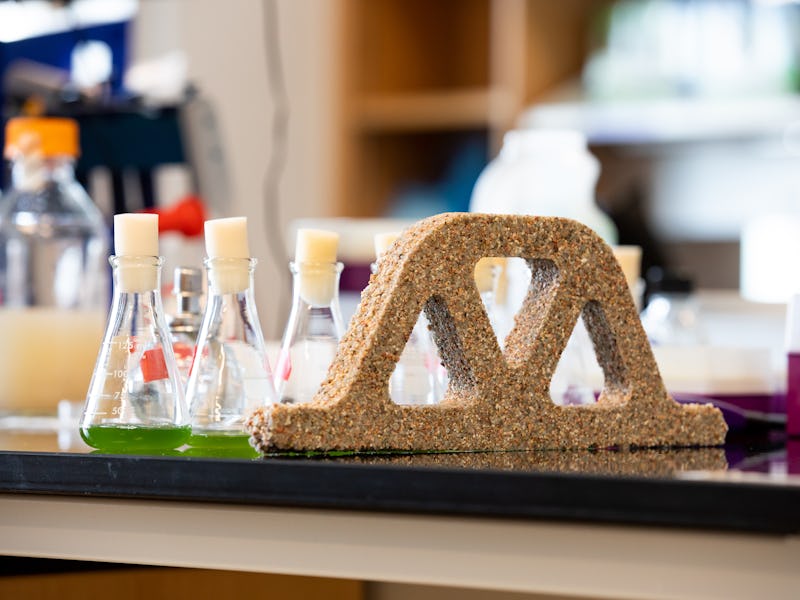This living building material could offer a green alternative to concrete
Scientists say this material could one day help build habitats on Mars.

Docile and dormant concrete is so last decade. Instead, scientists are now pushing the boundaries of material science and to design living, reproducible concrete — with a little help from bacteria.
A staple of everything from sidewalks to bridges to Brutalist architecture, concrete and cement have changed very little over the past hundred years. However, while this material has proven itself to be (fairly) reliable and stable, it has also proven to be a large source of CO2 pollution. A think tank reported that in 2015 emissions from the production of cement as well as the cement curing process accounted for 8 percent of global CO2 emissions. For comparison, the aviation industry only accounts for 2.5 percent and the US alone accounts for 16 percent.
But how do we break our dependence on concrete when its literally all around us?
To answer this question a new study, published Wednesday in the journal Matter has pushed the boundaries of traditional material science to design “concrete” using sand and the biological processes of bacteria. The resultant living concrete was not only as strong as traditional concrete but also greener and more easily reproduced.
Wil Srubar, the study’s senior author and head of the Living Materials Laboratory at the University of Colorado Boulder, said in a statement that the method demonstrated in their study could open the door to an entirely new frontier of material science.
“This is a material platform that sets the stage for brand new exciting materials that can be engineered to interact and respond to their environments,” said Srubar. “We are just trying to bring building materials to life, and I think that is the nugget in this whole thing. We’re just scratching the surface and laying the foundation of a new discipline. The sky is the limit.”
Above, the bacteria begins the process of growing and mineralizing to the sand-hydrogel scaffold.
The University of Colorado team was able to achieve this mix of strength and reproducibility by creating a scaffold of hydrogel and sand that a newly introduced bacteria, Synechococcus, was able to grow on. Drawing from nutrients and moisture held within the hydrogel, the bacteria were able to proliferate and mineralize, not unlike a shell developing in the ocean.
The research team was also able to demonstrate how the material’s “self-healing” capabilities could be beneficial for mass production in the future. The researchers observed that when split in half, the material would reform as two full pieces (kind of like a worm.) The team found that one piece of original material could be split into three generations to create eight total resultant pieces of material.
Srubar said in a statement that this self-healing and self-replicating nature of the material could be extremely useful in situations where lugging bags of concrete would not be possible. Say, Mars?
“In austere environments, these materials would perform especially well because they use light from the sun to grow and proliferate with very little exogenous material needed for their growth,” said Srubar. “It’s going to happen one way or another, and we’re not going to be trucking bags of cement all the way to Mars. I really do think that we’ll be bringing biology with us once we go.”
But… before we start building living habitats on Mars with this material, the research still has a number of kinks to work out. Namely, the material is extremely sensitive to temperature and humidity that is “non-optimum,” or less than 50 percent humidity and under 20 C (68 F.) In the current study, the researchers were able to use these environmental conditions as ways to toggle on and off the bacteria’s growth, but future research will need to address these sensitivities to create a more robust material.
Read the summary here:
Summary:
Living building materials (LBMs) were engineered that are capable of both biological and structural functions. LBMs were created by inoculating an inert structural sand-hydrogel scaffold with Synechococcus sp. PCC 7002, a photosynthetic cyanobacterium. The scaffold provided structural support for Synechococcus, which toughened the hydrogel matrix via calcium carbonate biomineralization. Temperature and humidity switches were utilized to regulate the metabolic activity of the microorganisms and achieve three successive regenerations of viable LBMs from one parent generation. Microbial viability in LBMs maintained in at least 50% relative humidity for 30 days was 9%–14%, which far exceeded literature values of microorganisms encapsulated in cementitious materials for similar timeframes (0.1%–0.4%). While structural function was maximized at ultradesiccated conditions, prolonged dehydration compromised microbial viability. Despite this tradeoff in biological-structural function, LBMs represent a platform technology that leverages biology to impart novel sensing, responsive, and regenerative multifunctionality to structural materials for the built environment.